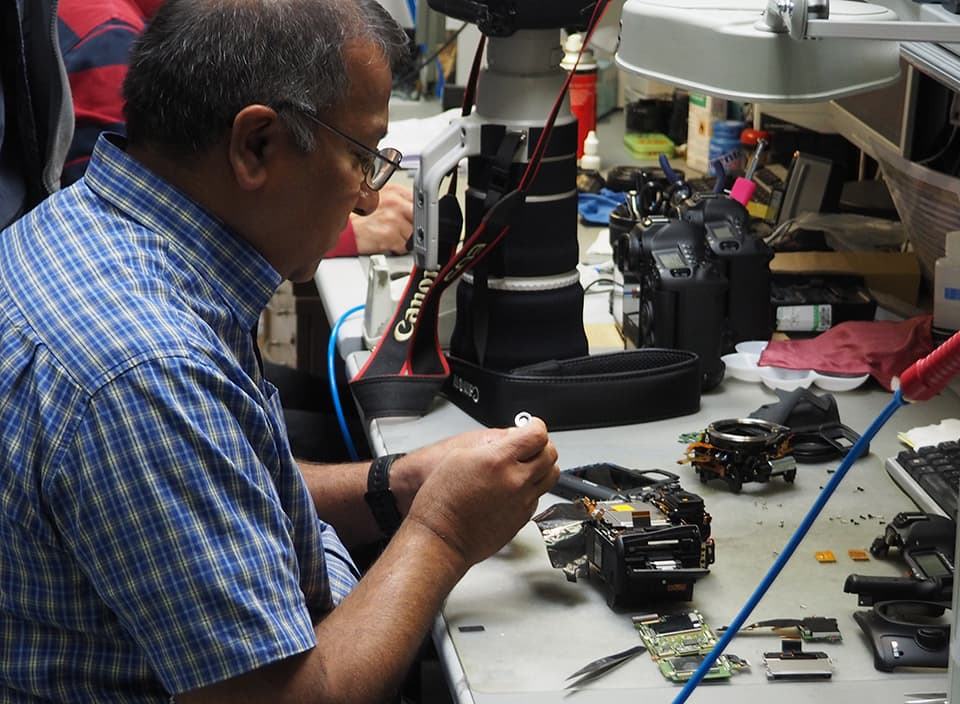It turns out this driver is well used to requests from photographers who simply want to drop off their cameras or lenses for servicing, then ask him to wait for the return trip to the station. Clearly, Canon is a big name around these parts. But we are not here for a camera repair. We are on a mission to see how the whole operation works.
As you may expect from one of the world’s largest camera brands, servicing and support is big business.
Europe-wide, the firm receives around 200,000 requests for technical support every year.
Upon arriving at the unassuming building on an unremarkable business park, we discover that it’s quite normal for customers to drop off cameras at reception, though most arrive by post or courier.
The Canon Service Centre – one of seven authorised camera repair points in the UK and Ireland – receives around 150 parcels per day and processes 145 telephone calls.
Staff can turn a camera repair around inside of two days for Platinum members of its Canon Professional Services (CPS) scheme. To qualify for this elite group, members must have three qualifying camera bodies from the EOS 5D or EOS-1D series. In Europe, it is free to join the CPS scheme, which also offers gold and silver membership options.
 CPS technician Kish Dhayatker gets to grips with a high-end DSLR. He is one of 15 technicians at the Canon Service Centre in Elstree
CPS technician Kish Dhayatker gets to grips with a high-end DSLR. He is one of 15 technicians at the Canon Service Centre in Elstree
However, it’s not just working professionals who send cameras in for a health check or repair job.
Many amateurs are among those whose DSLRs qualify for treatment. ‘The mix is roughly 50:50,’ says Darren O’Mahony, service director for Europe, the Middle East and Africa (EMEA).
‘For [enthusiasts] dropping cameras in for repairs we aim to turn around all cameras within eight days.’
The centre handles DSLRs from the EOS 70D upwards as well as professional video equipment, Speedlite camera flashes and flashguns, lenses, projectors and other accessories. Entry-level DSLRs and compacts are dealt with at a separate centre in Germany.
 Darren O’Mahony, service director for Europe, the Middle East and Africa
Darren O’Mahony, service director for Europe, the Middle East and Africa
The next few weeks could prove a busy time for staff, with technicians dispatched to provide onsite support to press photographers covering events such as Wimbledon, the UEFA Euro 2016 football championship and Formula 1 motor racing.
Among the centre’s 60 staff are 15 technicians. Basic training takes about 6-12 months, though most have 30 years’ experience in the job. Four technicians are assigned to mid-range DSLRs, while eight CPS staff work on higher-end lenses and cameras, such as the EOS 5D Mark III and EOS-1D X models.
‘We are largely a repair service but a lot of the work is centred around things like sensor cleans and adjustments,’ adds O’Mahony, who points out that occasional adjustments are needed when a photographer’s working tool gets knocked or dropped.
The cost of a repair depends on what needs doing, but the staff say they operate on a ‘no surprises’ policy and encourage customers to discuss the ‘diagnosis’ and repair with a technician beforehand.
AF adjustment, calibration or sensor cleaning in a ‘dust-free’ room may be the order of the day. However, occasionally, the centre calls out in a crisis, such as the time when a technician was asked to join a photographer on board a helicopter during an aerial shoot.
When asked what has been the service centre’s greatest challenge, O’Mahony says: ‘We’ve had lenses that have been sat on by elephants and we even had a lens that was infested by red ants. But these are rare cases.’ One camera also came a cropper when a stuntman rolled a car during a film shoot.
 Booking administrator James Dan
Booking administrator James Dan
One of the success stories is recounted by CPS technician Kish Dhayatker who explains that photographer Jonathan Scott was on assignment in the Masai Mara, Kenya, when he accidentally dropped his kit in some water. Five hours of TLC at Canon’s A&E, however, and it was ready for more action.
It’s not all about urgent repair work though. ‘A lot of the requests are simply for preventative maintenance,’ adds O’Mahony.
‘If a photographer knows they have an important shoot then they will quite often bring the product in a few days before the shoot, get the camera back up to spec and back out for work.’
Taking pride of place among the centre’s labyrinth of corridors and science-lab decor is a piece of equipment that nobody is allowed to see. It checks lens resolution and helps provides information about how a lens is set up.
‘This takes the technician’s judgement out of it because the software will analyse the image,’ says service centre manager Martin Donoghue. ‘It will tell the technician whether he needs to make adjustments.’
A 33m-long track allows technicians to test lenses of up to 600mm focal length. While, a shorter one, measuring 10m, is designed for lenses up to 200mm.
Owing to the machine’s vibrations and the need for consistent readings, there was a requirement for the concrete floor it sits on to have a maximum 5mm change in level from one end to the other.
We also spy some innocuous-looking test charts to check a camera’s focusing system, for example. However, such is the secrecy surrounding them that photographs of these are well and truly off limits… Time to get that taxi back to the station.
[All photos © C Cheesman]








